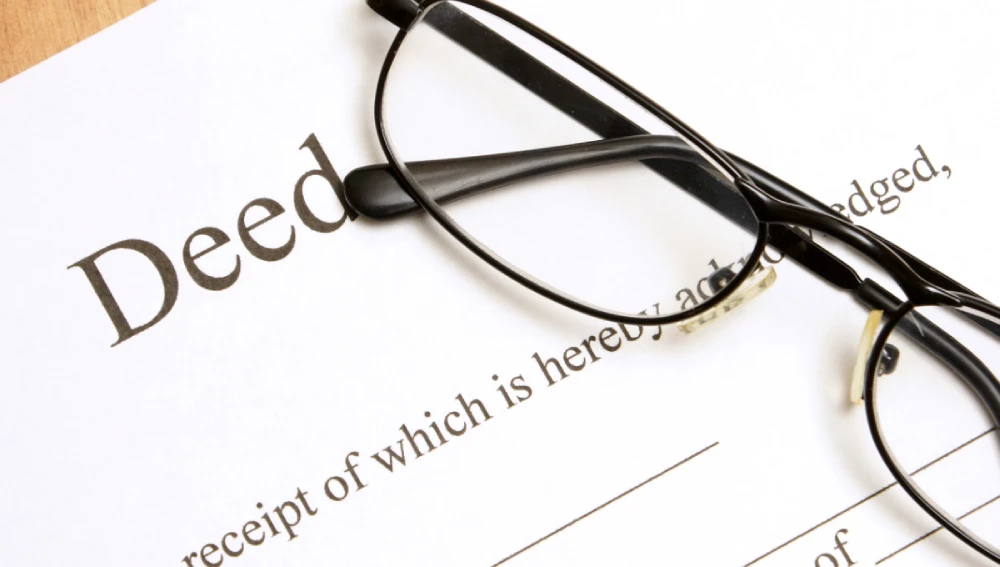To understand real estate transactions, one must differentiate between Sale Deeds and Conveyance Deed.Both documents have a big impact on transferring property ownership, but they serve different purposes and have different legal effects. This article will explain what sets these two deed types apart, what they contain, and how they work in property transactions.
What is a Sale Deed?

Sale deed is a legal document that essentially holds the key and acts as evidence of the transfer of the ownership from the seller to the buyer. This document is crucial in any property transaction, since it affirms that the sale has been made, defining the property’s specifics and the agreed sale price. Typically, people draw up a sale deed after both parties have agreed to the sale’s terms and conditions.
Key Parts of a Sale Deed
- Parties Involved: This part contains the names, addresses, and other significant details concerning the buyer and the seller.
- Property Description: It provides detailed description of your property by providing information on its details, dimensions, surroundings, and location.
- Sale Consideration: Reflects the price at which both the buyer and the seller of the property decided and the mode of payment to be made by the buyer.
- Transfer of Title: A simple statement to indicate an act of conveying the property by a seller to a buyer.
- Encumbrances: If you are purchasing the property through a loan by a financial institution or anybody, information on whether there is any encumbrance like mortgages or any other claim to the asset/property or the fact that the asset/property is clear of any such encumbrance.
- Possession: The particular calendar date on which the buyer gets the right to own the property.
- Covenants: Several things are stated by the seller about the condition of the property, and the rights granted to the buyer
- Witnesses: People who witness the signing of the deed append their signatures to it.
Conditions Which You Need to Fulfill in Drawing a Sale Deed
- Stamp Duty: In order for a sale deed to be legally valid, it is important to pay the stamp duty at the rates applicable in the state wherein the property is situated. The stamp duty is calculated based on the property’s market value or the sale consideration, whichever is higher.
- Registration: The sale deed must be registered at the local sub-registrar’s office in order to lawfully transfer the property to the buyer. The process of registration involves the payment of appropriate registration charges and will also mandate the submission of other supporting documents like ID proofs, property tax receipts, and certificates, and other relevant documents. The act that mandates this registration is the Indian Registration Act, 1908 and the registration process governing property transactions of a certain value.
Why a Sale Deed Matters
- Legal Ownership: It turns the buyer into the new legal owner of the property.
- Fraud Protection: It guards both sides by documenting the sale conditions and preventing potential disputes.
- Loan Processing: Banks and lenders require a sale deed to confirm ownership when they process home loans or mortgages.
What is a Conveyance Deed?

The term conveyance deed does not have a very narrow meaning, and it mostly remains for any document that may be used in any litigation procedure and for a deed of the demise of an interest in property from one person to the other. While a sale deed is utilized to convey the property, conveyance documents can comprise gift deeds, exchange deeds, and lease deeds, among others.
Key Parts of a Conveyance Deed
- Parties Involved: The names, addresses, and other essential details of the seller and buyer.
- Property Description: A complete rundown of the property changing owners.
- Type of Transfer: The way the property is handed over, like through a purchase, present, rental, or exchange.
- Consideration: The value of the transfer, which might be cash or something else.
- Transfer of Title: A straightforward statement showing the ownership shift from the seller to the buyer.
- Encumbrances: A mention of any current claims or rights on the property.
- Possession: The date the new owner will receive the property keys.
- Covenants: Various promises the seller makes about the property.
Types of Conveyance Deeds
- Sale Deed: Hands over property ownership through a sale.
- Gift Deed: Transfers ownership of property as a gift without any money exchange.
- Lease Deed: Gives property rights for a specific period in return for rent.
- Exchange Deed: Let two parties trade properties.
- Relinquishment Deed: Surrenders one’s portion of an owned property.
Legal Requirements to Create a Conveyance Deed
- Stamp Duty: The conveyance deed needs stamps based on current rates.
- Registration: To become valid, you must register the deed at your local sub-registrar’s office.
Why a Conveyance Deed Is Important
- Legal Transfer: It records the change in property ownership, protecting the rights of both parties.
- Clarity and Openness: It sheds light on the terms and conditions of the transfer.
- To Prevent Arguments: It spells out the rights and responsibilities of the people involved, helping to avoid disagreements.
How Sale Deed Differ from Conveyance Deed
| Factors | Sale Deed | Conveyance Deed |
| Scope | A type of conveyance deed that legally transfers ownership of a property from the seller to the buyer. | This type of deed includes all documents that transfer ownership rights of property, including gift deeds, exchange deeds, and sale deeds. |
| Payment | In general, the buyer pays the seller for the property. | Financial transaction, depends on the type of conveyance (e.g., gift deed might not involve payment). |
| Usage | Used specifically for the sale and purchase of property between two parties. | Used for various types of property transfers, including sale, gift, exchange, lease, and mortgage. |
| Nature | It is a binding agreement betweentwo parties for property sale with legal implications. | It covers a wider range of property transfers, encloses many legal mechanisms beyond just sale. |
Scope:
- Sale Deed: People use this to sell and transfer property ownership.
- Conveyance Deed: This covers more ways to transfer property, such as selling, gifting, leasing, and exchanging.
Payment:
- Sale Deed: Always requires money as payment because someone sells the property.
- Conveyance Deed: This can require money or other forms of payment, depending on how the property changes hands.
Usage:
- Sale Deed: A person uses this when they sell the property.
- Conveyance Deed: People apply this to transfer various types of property, not just for sales.
Nature:
- Sale Deed: This involves a buyer and a seller.
- Conveyance Deed: This can include different parties such as a gift-giver and a recipient in a gift deed, or a landlord and tenant in a lease deed.
Conclusion
Knowing the distinction between a sale deed and a conveyance deed matters a lot in property deals. People use a sale deed, which is a type of conveyance deed, when they sell the property. A conveyance deed, however, includes many different ways to transfer property. These documents have a key part to play in shifting property ownership and protecting the rights of everyone involved. People need to carry out, stamp, and register these deeds to make sure the deal is legal and safe.
FAQs
Yes. A Sale Deed is a type of deed in which property is transferred for sale. A conveyance document can be referred to as a document of sale, but in some instances, there are conveyance documents that are not documents of sale.
Yes. To make it legal, you need to have the sale deed registered at the sub-registrar office of the local area. This procedure entails such costs as stamp duty and registration fees.
If someone doesn’t register a document for selling or transferring property, the law won’t recognize the new owner. This can lead to arguments and legal trouble because the rules don’t see the deal as valid

